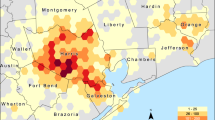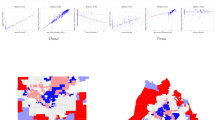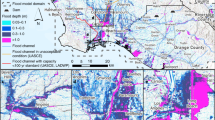Abstract
Disparities exist in post-disaster flooding exposure and vulnerable populations bear a disproportionate impact of this exposure. We describe the unequal burden of flooding in a cohort of New York residents following Hurricane Sandy and assess whether the likelihood of flooding was distributed equally according to socioeconomic demographics, and whether this likelihood differed when analyzing self-reported or FEMA flood exposure measures. Residents of New York City and Long Island completed a self-administered survey 1.5–4.0 years after the storm. Multivariable logistic regressions were performed to determine the relationship between sociodemographic characteristics and flood exposure. Participants (n = 1231) residing in areas of the lowest two quartiles of median household income experienced flooding the most often (FEMA/self-reported: <$40,298: 65.3%/42.0%, $40,298–$67,188: 43.3%/32.1%), and these areas contained the highest proportions of non-White participants (<$40,298: 39.1%, $40,298–$67,188: 36.6%) and those with ≤high school education (<$40,298: 35.5%, $40,298–$67,188: 33.6%). Both self-report (p < 0.05) and FEMA (p < 0.05) flood measures indicated that older participants were more likely to live in a household exposed to flooding, while those living in higher-income areas had decreased likelihood of flooding (p < 0.0001). Socioeconomic and age disparities were present in exposure to flooding during Hurricane Sandy. Future disaster preparedness responses must understand flooding from an environmental justice perspective to create effective strategies that minimize disproportionate exposure and its adverse outcomes.
This is a preview of subscription content, access via your institution
Access options
Subscribe to this journal
Receive 6 print issues and online access
$259.00 per year
only $43.17 per issue
Buy this article
- Purchase on Springer Link
- Instant access to full article PDF
Prices may be subject to local taxes which are calculated during checkout

Similar content being viewed by others
References
Agyeman J, Schlosberg D, Craven L, Matthews C. Trends and directions in environmental justice: from inequity to everyday life, community, and just sustainabilities. Annu Rev Environ Resour. 2016;41:321–40.
Holifield, R, Chakraborty, J, & Walker, G. The Routledge handbook of environmental justice. Routledge; 2017.
Walker G. Beyond distribution and proximity: exploring the multiple spatialities of environmental justice. Antipode. 2009;41:614–36.
Chakraborty J, Maantay JA, Brender JD. Disproportionate proximity to environmental health hazards: methods, models, and measurement. Am J Public Health. 2011;101:S27–S36.
Chakraborty J, Collins TW, Grineski SE. Exploring the environmental justice implications of Hurricane Harvey flooding in Greater Houston, Texas. Am J Public Health. 2019;109:244–50.
Alexander AC, Ali J, McDevitt-Murphy ME, Forde DR, Stockton M, Read M, Ward KD. Racial differences in posttraumatic stress disorder vulnerability following Hurricane Katrina among a sample of adult cigarette smokers from New Orleans. J Racial Ethn Health Disparities. 2017;4:94–103.
Rhodes J, Chan C, Paxson C, Rouse CE, Waters M, Fussell E. The impact of Hurricane Katrina on the mental and physical health of low-income parents in New Orleans. Am J Orthopsychiatry. 2010;80:237.
Lowe SR, Willis M, Rhodes JE. Health problems among low-income parents in the aftermath of Hurricane Katrina. Health Psychol. 2014;33:774.
Fussell Elizabeth, Sarah RLowe. “The impact of housing displacement on the mental health of low-income parents after Hurricane Katrina.”. Soc Sci Med. 2014;113:137–44.
Galea S, Brewin CR, Gruber M, Jones RT, King DW, King LA, Kessler RC. Exposure to hurricane-related stressors and mental illness after Hurricane Katrina. Arch Gen Psychiatry. 2007;64:1427–34.
Lieberman-Cribbin W, Liu B, Schneider S, Schwartz R, Taioli E. Self-reported and FEMA flood exposure assessment after hurricane Sandy: association with mental health outcomes. PloS ONE. 2017;12:e0170965.
U.S. Census Bureau. American Community Survey. 2012 American Community Survey 5-Year Estimates. Table B19013, 2012. http://factfinder2.census.gov.
MOTF, F. FEMA Modeling Task Force (MOTF)-Hurricane Sandy impact analysis. FEMA MOTF. 2014. https://www.arcgis.com/home/item.html?id=3a5c59699d86453a89f590171a10e9b5.
Amin R, Nelson A, McDougall S. A spatial study of the location of superfund sites and associated cancer risk. Stat Public Policy. 2018;5:1–9.
Schwartz RM, Gillezeau CN, Liu B, Lieberman-Cribbin W, Taioli E. Longitudinal impact of Hurricane Sandy exposure on mental health symptoms. Int J Environ Res Public Health. 2017;14:957.
Taioli E, Tuminello S, Lieberman-Cribbin W, Bevilacqua K, Schneider S, Guzman M, Schwartz RM. Mental health challenges and experiences in displaced populations following Hurricane Sandy and Hurricane Harvey: the need for more comprehensive interventions in temporary shelters. J Epidemiol Community Health. 2018;72:867–70.
Sullivan G, Vasterling JJ, Han X, Tharp AT, Davis T, Deitch EA, Constans JI. Preexisting mental illness and risk for developing a new disorder after Hurricane Katrina. J Nerv Ment Dis. 2013;201:161–6.
Petkova EP, Beedasy J, Oh EJ, Sury JJ, Sehnert EM, Tsai WY, Reilly MJ. Long-term recovery from Hurricane Sandy: evidence from a survey in New York City. Disaster Med Public Health Prep. 2018;12:172–5.
Bonanno GA, Galea S, Bucciarelli A, Vlahov D. What predicts psychological resilience after disaster? The role of demographics, resources, and life stress. J Consulting Clin Psychol. 2007;75:671.
Sirey JA, Berman J, Halkett A, Giunta N, Kerrigan J, Raeifar E, Raue PJ. Storm impact and depression among older adults living in hurricane Sandy–affected areas. Disaster Med Public Health Prep. 2017;11:97–109.
Dostal PJ. Vulnerability of urban homebound older adults in disasters: a survey of evacuation preparedness. Disaster Med Public Health Prep. 2015;9:301–6.
Smith SM, Tremethick MJ, Johnson P, Gorski J. Disaster planning and response: considering the needs of the frail elderly. Int J Emerg Manag. 2009;6:1–13.
Aldrich N, Benson WF. Disaster preparedness and the chronic disease nedds of vulnerable older adults. Prev Chronic Dis. 2008;5:1–7.
Acknowledgements
This work was supported by The Centers for Disease Control and Prevention under award number U01-TP000573-01, and the Office of the Assistant Secretary for Preparedness and Response under HITEP150029-01-00, as well as a private donation given to Northwell Health. The funders had no role in study design, data collection and analysis, decision to publish, or preparation of the manuscript.
Author information
Authors and Affiliations
Corresponding author
Ethics declarations
Conflict of interest
The authors declare that they have no conflict of interest.
Additional information
Publisher’s note Springer Nature remains neutral with regard to jurisdictional claims in published maps and institutional affiliations.
Supplementery information
Rights and permissions
About this article
Cite this article
Lieberman-Cribbin, W., Gillezeau, C., Schwartz, R.M. et al. Unequal social vulnerability to Hurricane Sandy flood exposure. J Expo Sci Environ Epidemiol 31, 804–809 (2021). https://doi.org/10.1038/s41370-020-0230-6
Received:
Revised:
Accepted:
Published:
Issue Date:
DOI: https://doi.org/10.1038/s41370-020-0230-6
Keywords
This article is cited by
-
Differential Exposure to Climate Change? Evidence from the 2021 Floods in Germany
The Journal of Economic Inequality (2024)
-
Health Disparities in the Aftermath of Flood Events: A Review of Physical and Mental Health Outcomes with Methodological Considerations in the USA
Current Environmental Health Reports (2024)
-
Methods in Public Health Environmental Justice Research: a Scoping Review from 2018 to 2021
Current Environmental Health Reports (2023)
-
A Census Tract-Level Examination of HIV Care Outcomes and Social Vulnerability Among Black/African American, Hispanic/Latino, and White Adults in the Southern United States, 2018
Journal of Community Health (2023)
-
Spatial regression identifies socioeconomic inequality in multi-stage power outage recovery after Hurricane Isaac
Natural Hazards (2023)



